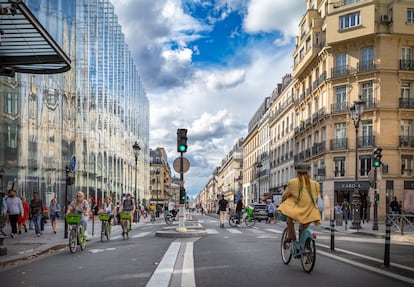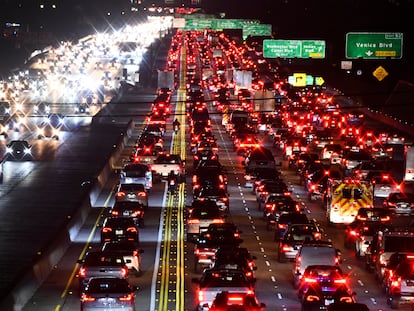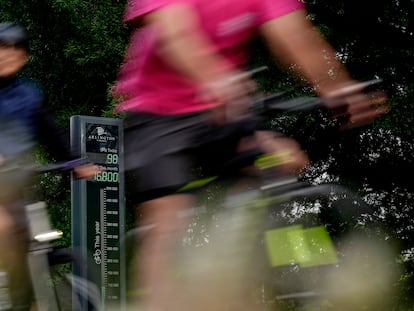The cycling revolution in Paris continues: Bicycle use now exceeds car use
A study indicates that 11.2% of trips in the French capital are made on two wheels, compared to 4.3% in four-wheel vehicles

It’s rush hour on Rue de Rivoli, one of the main arteries of the French capital. The bicycles pass one after another in quick succession, ringing their bell when a pedestrian crosses without looking. Five years ago, it was cars that monopolized this three-kilometer axis that runs in front of Paris City Hall and the Louvre Museum. Not anymore. Two-wheel transportation has prevailed, favored by a paradigm shift in urban mobility. The cycling revolution, promoted by local authorities, is beginning to bear fruit: according to a recent study by the Paris Région Institute, a public agency, bicycles already surpass cars as a means of transportation in the interior of Paris, accounting for 11.2% of trips compared to 4.3%. A similar trend is seen in trips between the suburbs and the city center: 14% are made by bicycle and 11.8% by car.
Rue de Rivoli, with its two-way cycle lanes and its dedicated lane for buses and taxis, is perhaps one of the most emblematic examples of the change that the city has experienced in recent years. But it’s not the only one. The perpendicular Boulevard de Sébastopol has become the route most frequented by cyclists, with figures that usually exceed 10,000 daily trips, according to the count kept by the association Paris en Selle.
When it is sunny, the density can be so high that traffic jams sometimes occur, and the narrowness of the lane causes friction between bikes, creating moments of tension. City officials led by Mayor Anne Hidalgo, a Socialist, have tried to remedy this situation by building other bike lanes on parallel streets.
From north to south and east to west, the map of the capital has been filled with infrastructure that gives the bicycle a privileged place. Paris has more than 1,000 kilometers (621 miles) of facilities adapted for cyclists, including more than 300 km (186 m) of bike lanes and 52 km (32 m) of provisional lanes, according to the latest available municipal data, from 2021. The rest are lanes shared with cars or lanes only marked with paint on the ground.
By 2026, local officials want the entire city to be suitable for two-wheel transportation. To this end, it has set aside $250 million, $100 million more than in Hidalgo’s first term. This summer’s Olympic Games will serve as an accelerator of this new “bike plan,” with routes that will allow access to the Olympic venues.
But there is still some way to go. The Paris en Selle association warns that only 27% of the “bike plan” has been carried out despite the fact that 62% of Hidalgo’s second term in office has already elapsed. The Deputy Mayor of Paris for Transportation, David Belliard, acknowledges that there are delays, but does not lose hope. Progress is noticeable.
In some thoroughfares, the number of bikes already surpasses vehicles. Between 2022 and 2023, the use of bike lanes doubled at peak times, according to data collected by the capital’s 128 counters. The goal is to create a network of cycling paths that run along the busiest metro lines, to unclog public transit and offer an equally fast and safe alternative for commuters.
The number of people who travel by bicycle has increased exponentially. Vélib, the municipal urban bicycle rental service, has increased its fleet with 3,000 new bikes since March. Edmée Doroszlai, a 62-year-old Parisian, still remembers the first time she started riding on two wheels in the early 1980s. “It was monstrous, almost impossible and very dangerous,” she says from the center of Paris, with her bike at her side.
“There is also a big change in how men behave when they see a woman on a bike,” she adds, alluding to the normalization of its use. The presence of adapted infrastructure, she confirms, has encouraged her to use it more, as have many families who travel on cycle paths with small children.
“We still have to go further,” Belliard insisted in an interview with BFMTV earlier this month. The councilor was reacting to the study by the Paris Région Institute, the regional urban planning and environment agency, which indicated that 11.2% of trips in Paris were made by bike between 2022 and 2023, compared to 4.3% by car. The change in trend is clear. In 2021, two wheels still represented 5.6% of trips, while cars were 9%, according to Belliard.

In addition to surpassing the car as a means of travel within Paris, the research indicates that residents of the nearest suburbs also prefer to use the bike, with 14% of trips compared to 11.8% for cars. The figures are even better during rush hour, when 18.9% of trips are made by bike and only 6.6% by car. Travel on foot, however, continues to lead mobility within the municipality with 53%, followed by those made on public transit, with 30%. The study was carried out with 3,337 residents of the capital region who agreed to be fitted with a GPS tracker.
The bike gradually gained popularity during the public transist strike that paralyzed the capital in December 2019, in protest of President Emmanuel Macron’s pension reform. But it was also prominent after the Covid confinement in 2020, when the city tested the so-called “coronapistes,” temporary cycling lanes that progressively became permanent. Like Rivoli’s.
Better connections with neighborhoods
“The network is very good,” says Arnaud Faure, 31, co-owner of the Bivouac Cycles bicycle repair shop in Saint Ouen, a banlieue (suburb) in the north of the city. He has been in the French capital for two years and every day he travels 13 km (8 miles) to get to work and again the same to get back home. He says that almost all of his journey is along bike paths. But he cites two drawbacks. On one hand, the lack of safe parking, a determining factor for bicycle use. On the other hand, the fact that “just like in big cities, traffic is dense and can sometimes be dangerous.”
In 12 years, car traffic has decreased by 40% in Paris, according to City Hall. “But these rapid changes in habits have been accompanied by tension” in the streets, the mayor has admitted. “It takes time for everyone to find their place and feel safe,” she added, following road regulations that seek to raise awareness about the shared use of public space. Last summer, posters appeared throughout the city reminding everyone that pedestrians have the priority and that the speed limit for cars is 30 km/h (18 mph).
The city’s plan includes increasing the number of parking spaces for bicycles. The goal is to build more than 130,000 new spots. “Parking at train stations must be developed on a massive scale,” stresses Aymeric Cotard, 29, a member of the association Mieux se déplacer à bicyclette [Better to get around by bike]. One of the large projects that should be completed this year, with 1,200 spaces, is located just behind the Gare du Nord, one of the busiest stations in France. For Cotard, however, it will be insufficient. In the Dutch city of Utrecht, the station has 12,500 spaces for bikes.
The idea is that people who live in the suburbs and take the train daily to work will also use the bicycle once they arrive in Paris. It is one of the main challenges of the coming years, along with facilitating continuous journeys between the capital and its suburbs. “This requires the banlieue cities to do their job and the city of Paris to also improve its entrances, which are inhospitable and unpleasant by bike,” warns Cotard. In addition, it is necessary to provide infrastructure for a flow of cyclists that will be even greater in the future.
The process takes time and has encountered some opposition. But the morphology of the city is changing, adapting to the bike. And, with it, its resilience to the effects of climate change.
Sign up for our weekly newsletter to get more English-language news coverage from EL PAÍS USA Edition
Tu suscripción se está usando en otro dispositivo
¿Quieres añadir otro usuario a tu suscripción?
Si continúas leyendo en este dispositivo, no se podrá leer en el otro.
FlechaTu suscripción se está usando en otro dispositivo y solo puedes acceder a EL PAÍS desde un dispositivo a la vez.
Si quieres compartir tu cuenta, cambia tu suscripción a la modalidad Premium, así podrás añadir otro usuario. Cada uno accederá con su propia cuenta de email, lo que os permitirá personalizar vuestra experiencia en EL PAÍS.
¿Tienes una suscripción de empresa? Accede aquí para contratar más cuentas.
En el caso de no saber quién está usando tu cuenta, te recomendamos cambiar tu contraseña aquí.
Si decides continuar compartiendo tu cuenta, este mensaje se mostrará en tu dispositivo y en el de la otra persona que está usando tu cuenta de forma indefinida, afectando a tu experiencia de lectura. Puedes consultar aquí los términos y condiciones de la suscripción digital.
More information
Archived In
Últimas noticias
There is as much life left to discover on planet Earth as that which is already known
Dozens presumed dead, around 100 injured in fire at Swiss Alps bar during New Year’s celebration
Is porn for women different from conventional porn? We spoke to those who make it
Cartagena de Indias is sinking: What can the city do to mitigate it?
Most viewed
- Reinhard Genzel, Nobel laureate in physics: ‘One-minute videos will never give you the truth’
- David King, chemist: ‘There are scientists studying how to cool the planet; nobody should stop these experiments from happening’
- Oona Chaplin: ‘I told James Cameron that I was living in a treehouse and starting a permaculture project with a friend’
- Sinaloa Cartel war is taking its toll on Los Chapitos
- The Interoceanic Train, the Mexican alternative to the Panama Canal











































